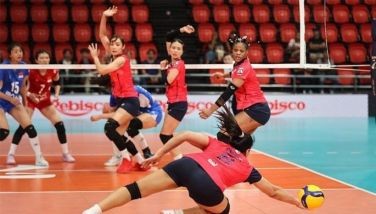Paeng: Proud to be Pinoy
August 29, 2006 | 12:00am
Last year, in a television program taped several days before the opening day of the 23rd Southeast Asian Games (SEA Games), I was asked who I thought was the greatest Filipino athlete ever. Without hesitation, I said it had to be ten-pin bowler Rafael (Paeng) Nepomuceno.
The show, which was aired on the opening day of the SEA Games, featured other sports personalities who were asked the same question. The consensus was Nepomuceno is indeed the greatest Filipino athlete.
I did not hesitate again to choose Nepomuceno as the most outstanding sports person inducted into the De La Salle University (DLSU) Sports Hall of Fame when the DLSU alumni association asked me recently to give my choice of the most outstanding De La Salle athlete to be featured in an alumni publication to commemorate the association’s 40th anniversary.
The question led me to revisit Nepomuceno thus giving me the opportunity to meet him again after I left the Philippine Sports Commission in July 1998.
Nepomuceno finished grade school and high school at La Salle Green Hills (LSGH) in 1971 and 1975 respectively. He was the first inductee in the LSGH Sports Hall of Fame and was inducted into the DLSU Hall of Fame in 2003.
My main criterion for choosing the greatest Filipino athlete is the pioneering or ground-breaking work the sports personality did in his sport. The fact that he blazed the trail in his sport and created such a tremendous impact is the most important factor I considered in making my judgment of which Filipino athlete should be given that honor.
Surely, there are a number of athletes over the last century that created a tremendous impact on Philippine sports. Pancho Villa, definitely blazed the trail by becoming the first Filipino to have won a world boxing title. David Nepomuceno (no relation to Paeng), was the first Filipino to have participated in the Olympics. Nepomuceno ran the 100 meters in 10.8 seconds in the 1924 Paris Olympics.
Teofilo Yldefonso, known during his heyday as the "Ilocano Shark," is considered the finest Filipino swimmer ever and is best known for two feats: the first Filipino to win an Olympic medal and the only Filipino to have won two Olympic medals. Yldefonso won a bronze medal in the 200-meter breaststroke in the 1928 Amsterdam Olympics and his second in the same event in Los Angeles in 1932. Another Filipino, Simeon Toribio was a bronze medal in the high jump event in Los Angeles.
It is said that Toribio could have won the gold were not for the "call of nature." Author Jorge Afable says that after a grueling four-hour competition, Toribio, who was later elected congressman of Bohol, settled for the bronze after clearing 6’6" the first time but failing to do so in the second time because "he was distressed by the call of nature." Toribio missed winning the bronze in the Amsterdam Olympics four years earlier.
Nepomuceno is a six-time world champion and is acknowledged worldwide as the greatest international bowler in the history of the sport. In recognition of his achievements, Juan Antonio Samaranch personally awarded Nepomuceno with the prestigious International Olympic Committee (IOC) President’s Trophy which is the first for the sport of bowling.
Gerald L. Koenig, then president of the Federation Internationale des Quilleurs (FIQ), said on Nov. 21, 1999 in congratulating Nepomuceno for the IOC award, "On behalf of 100 million bowlers in the world, I salute Paeng Nepomuceno as the international bowling athlete of the millennium."
I first met Nepomuceno in 1977 when I did a write up on him for the then Celebrity Magazine of Rod Reyes. At that time, Nepomuceno had been bowling competitively for about seven years and was fresh from his triumph at the Bowling World Cup (BWC) in Tehran, Iran on Nov. 19, 1976. At 19, Nepomuceno had become bowling’s youngest world champion.
Five more world championships came after the Tehran title: 1980 BWC in Indonesia, the 1984 World Invitational Tournament (a 1984 Olympics side event) in Las Vegas; 1992 BWC in Le Mans, France; 1996 BWC in strife-torn Belfast, Northern Ireland and the 1999 World Ten Pin Masters in London, England.
As further proof of the high regard the international bowling and sports community have for Nepomuceno, the International Bowling Hall of Fame has on display at its museum in St. Louis, Missouri, a glass-encased seven foot photo of the 6’2", 200-lb Nepomuceno. In addition, the 1994 edition of the Guinness Book of World Records listed Nepomuceno as having won the most number of World Cups which were achieved in three different decades.
The Guinness Book of World Records 2003 edition listed a second world record: Nepomuceno was the youngest ever to win a world title at the age of 19. The 2003 edition also updated the number of World Cup titles won by Nepomuceno as it included in its records his fourth World Cup victory in Belfast.
In the Philippines, Nepomuceno became the first athlete to be bestowed both the Legion of Honor medal (by then President Joseph Estrada) which is the highest award for a Filipino and the Presidential Medal of Merit in 1984. Nepomuceno is the first Filipino to win in a world championship not using weight divisions or age groupings.
In December 1999, the Philippine Sportswriters Association (PSA) named Nepomuceno as "Athlete of the Year" for an unprecedented five times and made him its first inductee into the PSA Hall of Fame. Nepomuceno was subsequently named by the PSA "Athlete of the Century." Both houses of Congress named Nepomuceno "the Greatest Filipino Athlete of All Time."
Nepomuceno is married to Saira (Pinky) Puyat, managing director of the AMF-Puyat chain of bowling centers. They have three children: 20-year-old Rafael Jose who is now studying in San Diego, California; Margarita Paz, born on Nov. 22, 1990 and Isabel Angela, born on March 15, 1996.
Right now, Nepomuceno is earnestly preparing for the next World Cup competitions in November and the Asiad in Doha, Qatar. The wrist injury he sustained is completely healed and he’s well on his way to putting the Philippines back into the international bowling map.
The show, which was aired on the opening day of the SEA Games, featured other sports personalities who were asked the same question. The consensus was Nepomuceno is indeed the greatest Filipino athlete.
I did not hesitate again to choose Nepomuceno as the most outstanding sports person inducted into the De La Salle University (DLSU) Sports Hall of Fame when the DLSU alumni association asked me recently to give my choice of the most outstanding De La Salle athlete to be featured in an alumni publication to commemorate the association’s 40th anniversary.
The question led me to revisit Nepomuceno thus giving me the opportunity to meet him again after I left the Philippine Sports Commission in July 1998.
Nepomuceno finished grade school and high school at La Salle Green Hills (LSGH) in 1971 and 1975 respectively. He was the first inductee in the LSGH Sports Hall of Fame and was inducted into the DLSU Hall of Fame in 2003.
My main criterion for choosing the greatest Filipino athlete is the pioneering or ground-breaking work the sports personality did in his sport. The fact that he blazed the trail in his sport and created such a tremendous impact is the most important factor I considered in making my judgment of which Filipino athlete should be given that honor.
Surely, there are a number of athletes over the last century that created a tremendous impact on Philippine sports. Pancho Villa, definitely blazed the trail by becoming the first Filipino to have won a world boxing title. David Nepomuceno (no relation to Paeng), was the first Filipino to have participated in the Olympics. Nepomuceno ran the 100 meters in 10.8 seconds in the 1924 Paris Olympics.
Teofilo Yldefonso, known during his heyday as the "Ilocano Shark," is considered the finest Filipino swimmer ever and is best known for two feats: the first Filipino to win an Olympic medal and the only Filipino to have won two Olympic medals. Yldefonso won a bronze medal in the 200-meter breaststroke in the 1928 Amsterdam Olympics and his second in the same event in Los Angeles in 1932. Another Filipino, Simeon Toribio was a bronze medal in the high jump event in Los Angeles.
It is said that Toribio could have won the gold were not for the "call of nature." Author Jorge Afable says that after a grueling four-hour competition, Toribio, who was later elected congressman of Bohol, settled for the bronze after clearing 6’6" the first time but failing to do so in the second time because "he was distressed by the call of nature." Toribio missed winning the bronze in the Amsterdam Olympics four years earlier.
Nepomuceno is a six-time world champion and is acknowledged worldwide as the greatest international bowler in the history of the sport. In recognition of his achievements, Juan Antonio Samaranch personally awarded Nepomuceno with the prestigious International Olympic Committee (IOC) President’s Trophy which is the first for the sport of bowling.
Gerald L. Koenig, then president of the Federation Internationale des Quilleurs (FIQ), said on Nov. 21, 1999 in congratulating Nepomuceno for the IOC award, "On behalf of 100 million bowlers in the world, I salute Paeng Nepomuceno as the international bowling athlete of the millennium."
I first met Nepomuceno in 1977 when I did a write up on him for the then Celebrity Magazine of Rod Reyes. At that time, Nepomuceno had been bowling competitively for about seven years and was fresh from his triumph at the Bowling World Cup (BWC) in Tehran, Iran on Nov. 19, 1976. At 19, Nepomuceno had become bowling’s youngest world champion.
Five more world championships came after the Tehran title: 1980 BWC in Indonesia, the 1984 World Invitational Tournament (a 1984 Olympics side event) in Las Vegas; 1992 BWC in Le Mans, France; 1996 BWC in strife-torn Belfast, Northern Ireland and the 1999 World Ten Pin Masters in London, England.
As further proof of the high regard the international bowling and sports community have for Nepomuceno, the International Bowling Hall of Fame has on display at its museum in St. Louis, Missouri, a glass-encased seven foot photo of the 6’2", 200-lb Nepomuceno. In addition, the 1994 edition of the Guinness Book of World Records listed Nepomuceno as having won the most number of World Cups which were achieved in three different decades.
The Guinness Book of World Records 2003 edition listed a second world record: Nepomuceno was the youngest ever to win a world title at the age of 19. The 2003 edition also updated the number of World Cup titles won by Nepomuceno as it included in its records his fourth World Cup victory in Belfast.
In the Philippines, Nepomuceno became the first athlete to be bestowed both the Legion of Honor medal (by then President Joseph Estrada) which is the highest award for a Filipino and the Presidential Medal of Merit in 1984. Nepomuceno is the first Filipino to win in a world championship not using weight divisions or age groupings.
In December 1999, the Philippine Sportswriters Association (PSA) named Nepomuceno as "Athlete of the Year" for an unprecedented five times and made him its first inductee into the PSA Hall of Fame. Nepomuceno was subsequently named by the PSA "Athlete of the Century." Both houses of Congress named Nepomuceno "the Greatest Filipino Athlete of All Time."
Nepomuceno is married to Saira (Pinky) Puyat, managing director of the AMF-Puyat chain of bowling centers. They have three children: 20-year-old Rafael Jose who is now studying in San Diego, California; Margarita Paz, born on Nov. 22, 1990 and Isabel Angela, born on March 15, 1996.
Right now, Nepomuceno is earnestly preparing for the next World Cup competitions in November and the Asiad in Doha, Qatar. The wrist injury he sustained is completely healed and he’s well on his way to putting the Philippines back into the international bowling map.
BrandSpace Articles
<
>
- Latest
- Trending
Trending
Latest
Trending
Latest
Recommended























